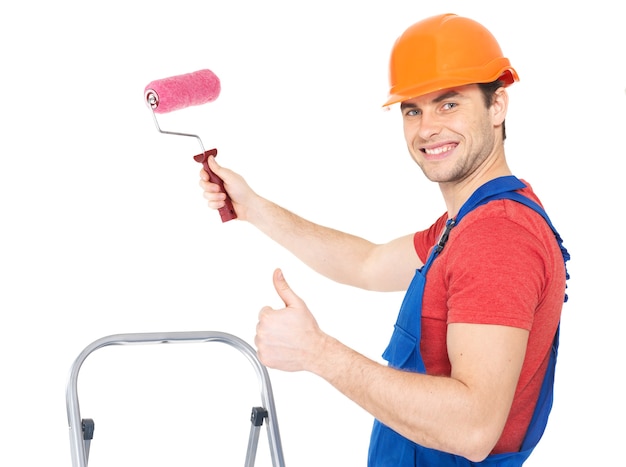It is best to lap your brush on a flat surface. Having good distemper or illustrator paint for a smooth wall painting won’t give you a long-lasting beautiful wall. Along with those quality paints, you need to add some more effort to make more excellent outcomes.
Now thinking of that, you have to learn some of the essential components to make your interior walls more and more beautiful. But only good equipment and tools can’t provide a good outcome for your wall, and a few things need to cover before and after painting the walls. There are differentiated types of walls to paint; like in old or rusty walls, you may need to work hard. Perhaps, for the newly plastered walls having a fresh look is important where it is pretty easy to do the painting. If you eager to know how to prepare a wall for painting? Then let’s discuss some professional steps for a wall painting job in the next paragraph.
Steps for Wall Preparation for Painting: How to Prepare a Wall for Painting?
Before straight head for the wall painting job, you need to learn the current conditions of your house partitions. If you have a new wall to paint, then the tasks will reduce where all you just need to prepare for the paint coating. But suppose you have a renovated wall to complete your paintwork, then following the steps are very necessary to learn. Now, if you concern about getting a professional finishing paint job, then read those steps carefully for more accuracy and don’t miss apart from the list.

Prepare a Newly Plastered Wall
Most probably, when you get new furnished plastered walls in new construction, then you don’t need to pull the previous scratch. It is very easy to use a roller because it has a clean and plain surface to roll or dice the paints brush. Generally, not require to do any scabbing job and make sure about the surface sealer so that the plaster won’t soak up the paints like a sponge bar. Let the barriers get dry before coating the paint. It is best to use dark patches on the new walls. On the other hand, light colors can fade away on the plaster walls very soon. If there are any holes or gaps between the walls, then cover that part with cement, or the paint will stick into these places and won’t dry.
Steps for Preparing Old Surfaces
There is no need to apply many paints on the old surfaces as it is already stable to get the shade from the inside. For the old wall, painting is easier if you can line up the following steps, giving you a professional paint finish.

- Fill in Any Holes or Cracks
Step 1: Find any gaps and then clean those places with sugar soap before wiping your paintbrush to the walls. It will help to prevent the filler sticking problem into the walls.
Step 2: Grab a flexible bar or stick to push the filler into the gap for a smooth and flat surface. It may get stuck inside or may not fulfill the gap appropriately. For that, use rubber pudding to cover the unzipped sides.
Step 3: On the next step, keep the filler open to dry onward. Now apply thick sandpaper and rub to get a smooth finishing in those cracks.
- Polish The Walls Perfectly.
Step 4: In this step, you have to keep fine sandpaper and apply that lightly sandpaper all over the walls to peel the old paint coating. It will help the wall to bind the surfaces with a beautiful texture instantly.
- Clean The Walls

Step 5: After getting a finish line of the walls, get ready for the clean operation. Remove the stains of grease, dust, finger laps, or any other spots with the help of sugar soap. Mix the soap liquid into the water or get the ready-mixed spray solution from the market.
Step 6: Always wear gloves while cleaning the walls, as those soaps are very harmful to the skin and may dehydrate your hands.
Step 7: Finally, wash the soap bubbles with warm water once you are done cleaning. So that no traces leave and let the walls get dry for 1 or 2 days toward painting.
Tools for Wall Painting,
- Sugar soap
- Flexible filler
- Flexible filling knife
- Fine sandpaper
- Sand the walls
- Sponge and Gloves
Steps for Preparing Previously Wallpapered Surfaces
Previously, if you had wallpapered surfaced, then it is best to start your painting to remove the paper peels and not to paint over those paper surfaces. You can peel off those junks from your walls and give a flat surface for the wall painting with a bit of effort. However, wallpapers are pasted with gums or glues. So, when the paper gets pulled off, the wall can look rusty or unfit for the paint. Now here are some standard solutions on how to prepare previously wallpapered surfaces for painting? Given below;

Step 1: Pull the attached papers with a stripping knife or sharp blade, and be careful with the plaster behind the wallpapers.
Step 2: If you peel off the wallpaper recklessly, then it may end up with an unfinished job to remove all the tiny paper pieces. For that, soak the wallpaper through a sponge and warm water for an easier take-off process. Be careful with the electrical sockets and switch not to get wet while extracting the wallpapers.
Step 3: Still, if you have trouble peeling off the papers, you can try the wallpaper stripping solution to unmerge the paste from the walls. Keep it on until all the wrappers come out from the surfaces automatically. But don’t let it appears for long as it will damp your wall’s moisturization.
Step 4: Once the paper is off to the walls, try using a sheet of sandpaper to help get rid of the leftover. Apply a new piece of light sandpaper to polish correctly for the perfect surfaces.
Step 5: Repeat this process until all wallpaper gets removed from the walls.
Tools for the job,
- Stripping knife or orbital blade
- Sponge and bucket
- Wallpaper stripping solution
- Steam stripper
- Sandpaper
- Sugar soap
Conclusion
Till now, we have made all the possible steps that are useful to get a furnish wall for painting. Along with the before and after job participation, we have covered some basic steps that will let you paint your wall smoothly. Hope you may get additional coverage from all those essential tips given by the experts and make your home more elegant with perfect wall paint.



